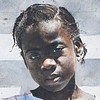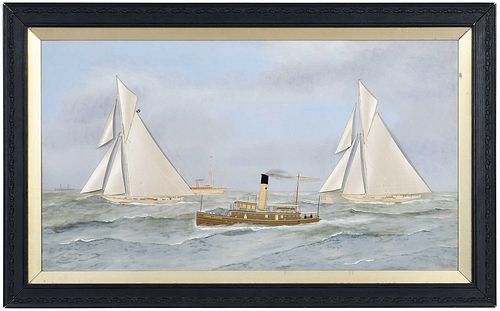Thomas H. Willis
Bid Increments
| Price | Bid Increment |
|---|---|
| $0 | $25 |
| $100 | $50 |
| $1,000 | $100 |
| $2,000 | $200 |
| $3,000 | $250 |
| $5,000 | $500 |
| $10,000 | $1,000 |
| $20,000 | $2,000 |
| $50,000 | $5,000 |
| $100,000 | $10,000 |
(Danish/American, 1850-1925)
Shamrock and Reliance III Crossing the Line at the 1903 America's Cup, signed lower right "T. Willis, N.Y., 1904, mixed media: oil on canvas with silk thread and silk and velvet fabric, sight 20 x 36 in.; wood frame, 26 x 42 in.
A” three-dimensional” oil painting, depicting the 1903 America's Cup yacht race outside New York Harbour between the contenders Reliance (entered by the New York Yacht Club) and Shamrock III, (representing the Royal Ulster Yacht Club). The name embroidered on the bow of the accompanying steamboat, is that of Edward J. Bergwind, one of the titans of industry of that period. Bergwind was a philanthropist and a member of the New York Yacht Club.
Condition
wonderful condition with some minor crackle in the sky. All of the silk details are intact, one loose shroud, even though the original glass has been exchanged (probably around 1942-43), due to a BB gun projectile hitting the frame. A small dent can be detected on upper right-hand edge.
Purchased items will be available for pick up or shipping from our Asheville, North Carolina auction facility within ten business days of the auction will be assessed a storage fee of $5.00 per day, per item. Purchaser agrees that packing and shipping is done at the purchaser's risk and that the purchaser will pay in advance all packing expenses, materials, carrier fees and insurance charges. At our discretion, items will either be packed by an agent such as a packaging store or Brunk Auctions. Please allow two weeks for shipping after payment is received. Shipment of large items is the responsibility of the purchaser. We are happy to provide names of carriers and shippers if a purchaser so requests. Brunk Auctions will have no liability for any loss or damage to shipped items.
At the beginning of the 1900s the painting was brought to Denmark by JOHAN CHARLES WILLIAM BECHSHØFT (1857-1939). Charles W. Bechshøft was the owner and director of a private business importing American typewriters and calculating machines. CWB’s sales office was located in the centre of Copenhagen, and he owned a villa in Hellerup, a wealthy suburb. He was a member of the Royal Danish Yacht Club, and owned several smaller sailing boats.
In 1902 CWB went to America on business. In New York he met the inventor James Bartlett Hammond (1839-1913), owner of The Hammond Typewriter Co.,
with whom he signed an agreement about a position as an overseas agent. In 1906 CWB rose to the position of European General Agent for the Hammond factory, whose HQ was located at 639 E. 69th St., on the Upper East Side of Manhattan Island, New York.
From 1914 CWB also sold machines from the Dalton Adding Machine Company.
(Located in Norwood, Ohio, near Cincinnati). The founder and owner, James Lewis Dalton (1866-1926), was a close friend and visited CWB in Copenhagen, and in 1919 CWB was given the title of Dalton supervisor General for Europe.
Over the following thirty years CWB, the European sales agent for the typewriter factories Hammond, Sun and Dalton, criss-crossed the Atlantic Ocean as a passenger more than 40 times. He preferred using the Danish company, DFDS, (The United Steamship Company) where he was a popular passenger as well as a very good friend of the captains.
CWB was known as "The International Typewriter man", both in Europe and in America, and every time he visited New York, he paid a visit to the office of the business journal Typewriter Topics in order to meet friends and contacts and to enquire about the latest business news. (https://typewriter152.rssing.com/chan-9584217/article350-live.html )
In New York CWB came into contact with a wide circle of sail sport enthusiasts. He followed the important events, among them the AMERICA’S CUP RACE. His friend and business associate, James B. Hammond was well known among early yachtsmen, and most probably CWB had been visiting on board James B. Hammonds 95-foot luxury yacht, Lounger II. (In 1913 Hammond died on his boat).
During his long stays in New York, the cosmopolitan CWB, with his outgoing personality, flair for languages, and social talents, frequented many different society clubs. Here he could have been introduced to the two marine artists, Thomas H. Willis, (1844–1925) born in Denmark, as well as to the somewhat younger Danish painter, Antonio Jacobson, (1850-1921) whose home in Hoboken, New Jersey was a Mecca for seafarers and artists. On Sundays Jacobson (whose father had been a violin builder in Copenhagen) enjoyed arranging concerts for friends and clients (mostly ships officers, crewmen and owners.)
Thomas H. Willis` work has probably been in CWBs possession from around 1908. There is no direct indication of how he acquired the painting. (It could have been a gift from his business associate James B. Hammond?)
After CWB died in 1939, the painting went to his son, Adolf J. Bechshøft (1891-1959), who left it to his son, James Henrik Charles Bechshøft (1921-2022), who recently left it to his children.

























